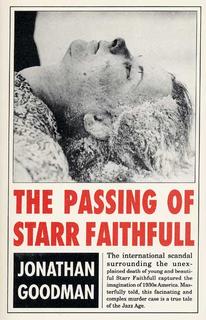Starr Faithfull: Inside the Books

Jonathan Goodman was given unlimited access to police records as he researched his theory about Starr Faithfull's untimely death.
Reviewer: Donna J. Spindel
The Passing of Starr Faithfull
Author: Jonathan Goodman
(Kent, Ohio: Kent State University Press, 1996. 311 pages)
Unimpressed, critic Donna Spindel observed that this is a peculiar book to describe. According to Spindel, the author has been called a "crime historian," and has written many books in the "true crime genre." Jonathan Goodman presents the story of Starr Faithfull, a young Manhattan woman whose body was found on 8 June 1931, when it washed up on the Long Island shore. The mystery of her death, which has never been solved, apparently captured the interest of the media, both in the United States and Britain, for a number of months. Goodman tries to dissect the case from every angle, using all the documentary evidence that is available to him, which is considerable, and offers his own conclusion as to how Starr Faithfull died.
.
The problem with this approach, from a scholarly perspective, is that it lacks context. There is little effort here to place Faithfull's story in time and place, to relate her death, if such a relationship even exists, to America during the Depression, or to the social class of which she seemed to be a part.
As Goodman shows, Faithfull's background itself is something of a mystery. She was the stepdaughter of Stanley Faithfull, a man whose source of income was uncertain, but apparently it was sufficient for the family to five relatively well. As a young girl she spent a good deal of time with her mother's cousin by marriage, Andrew Peters, the one-time mayor of Boston. Although never proved, Peters may have sexually abused the child. The record does show that he made financial payments to the Faithfulls. Starr was educated at schools for the rich, her expenses paid by wealthy relatives. As a young woman, she seemed depressed and unsure about her future; she may have been a drug user, and certainly she drank too much. Despite the fact that her parents stayed one step ahead of their creditors, she made repeated trips to Britain and was known there among the "well to do"; this accounts for the interest of the British press in her death. Yet, there is a major problem with the story. Goodman fails to show why we should take such a keen interest in her death.
.
Perhaps this tragic mystery will appeal to avid readers of crime stories.
Goodman certainly offers every possible piece of available evidence, sometimes quoted verbatim at length, including the autopsy report. But the writing is very uneven, awkward, and, in places, a bit embarrassing. He employs a number of old-fashioned phrases, such as "man and wife," "gossipy" mother, and "she bore him a child." None of this, in itself, is a fatal flaw, but the reader should be aware that this book has shortcomings. Nonetheless, if one is interested in knowing, in the finest detail, the story surrounding the death of Starr Faithfull, which purportedly was the basis for John O'Hara's Butterfield 8, this would surely be the book to read.
This book review was written by: Donna J. Spindel
This review was published in Historian [Spring 1998]
- - COPYRIGHT 1998 Phi Alpha Theta, History Honor Society, Inc. - -
http://StarrFaithfull.blogspot.com/atom.xml
starr faithfull
Starr Faithfull.



<< Home